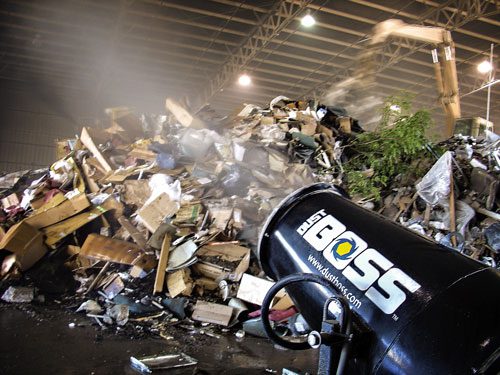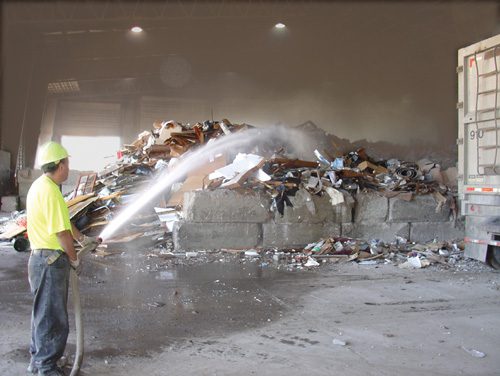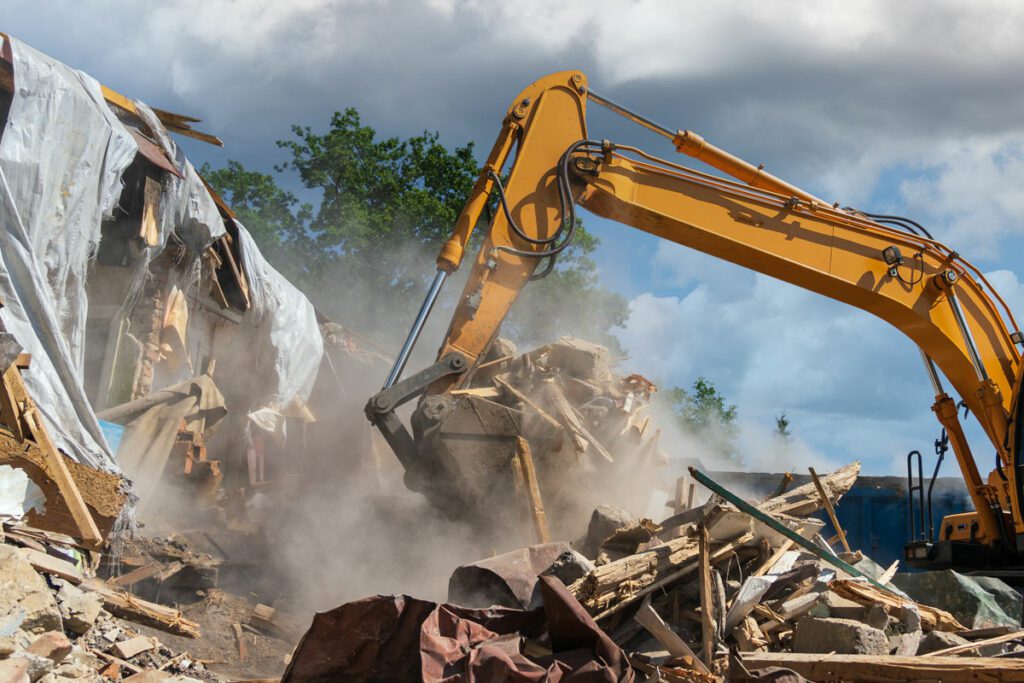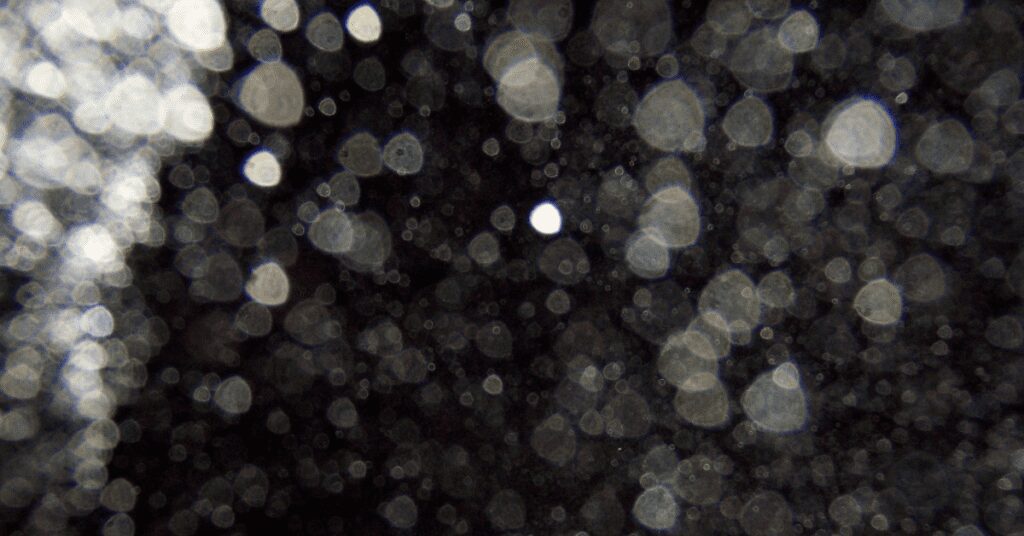 Like many transfer stations and recycling facilities, the Resource Recovery Technologies staff at a a transfer station in Minneapolis, MN (US) had been battling fugitive dust by manually spraying with a fire hose.
Like many transfer stations and recycling facilities, the Resource Recovery Technologies staff at a a transfer station in Minneapolis, MN (US) had been battling fugitive dust by manually spraying with a fire hose.
The approach required a worker to stand and spray incoming debris all day long, and the results were mixed, at best.
The facility typically receives 250 truckloads of residential refuse, yard debris, and wood scraps each day, processing about 450 tons of debris, operating five days a week.
“We found several disadvantages to manual spraying for dust control," said Site Supervisor Ken Tritz. “The technique was only marginally successful in knocking down the airborne particles, leaving us with a visible dust cloud all day. As a result, the air filters on our heavy equipment needed frequent replacement, which drove up operating costs.”
According to Tritz, that approach also saturated the debris piles, which became a major issue.
“The oversaturated material was far heavier as a result of the constant spraying,” he said. “That meant we were using more fuel in trucks hauling to the landfill, essentially paying extra to transport the water weight in each load. When we looked at the increased costs, the added manpower required and the potential for slipping on floors with standing water, we knew we needed a better solution.”
Dust Control By Design
While researching dust suppression methods as alternatives to manual spraying, Tritz came across the DustBoss, a fully automatic high pressure misting system designed specifically for dust control.
“After just a few days, we noticed a dramatic improvement in the air quality,” said Tritz.
“Visibility was greatly improved and we no longer needed to waste manpower by having a worker spraying a fire hose over the material all day.”
The DustBoss DB-30 was so effective that air filters on the site's heavy equipment lasted far longer, and the material being trucked to landfill did not become oversaturated in the process, which translated to reduced fuel consumption.
The DB-30 requires only 15 PSI of constant pressure, and water is supplied by a standard 5/8" garden hose. This unit is designed from the ground up for effective dust suppression. Some equipment suppliers modify existing equipment designs to serve the dust control market, but the DB-30 has been developed specifically for this purpose, including the nozzles, plume, spray angles and throw.
“We were spending 4 to 6 man hours each day, trying to control the dust manually.
Now we’ve eliminated that wasted effort and we’ve significantly reduced the time required to constantly inspect and change air filters on our wheel loader and other heavy equipment.
It’s also created a better work environment and contributed to improved employee morale.”
- Ken Tritz
Site Supervisor
Featuring a 7.5 HP motor that generates 9,200 CFM and a ring of 30 specially-designed nozzles, the ducted fan dust suppression machine has an adjustable throw angle from 0–50° elevation, with 70° of oscillation and a range of up to 100 feet for excellent coverage.
Between the manpower savings, reduced fuel costs and longer air filter life, Tritz estimated that the payback on the unit was less than a year.
“We were spending 4–6 man hours each day, trying to control the dust manually,” he said. “Now we’ve eliminated that wasted effort, and we’ve significantly reduced the time required to constantly inspect and change air filters on our wheel loader and other heavy equipment. It’s also created a better work environment and contributed to improved employee morale.”
Known for its durable construction and reliable service, the DB-30 typically requires minimal maintenance. Users need to inspect the nozzles once a year when using a potable water supply. The fan motor should be lubricated about once every five years, depending on the service environment, and the oscillator is greased for life.
The DB-30 can also be set up to run from a non-potable water supply. Additional options include a dosing pump that can be used to automatically meter in odor control additives or surfactants for superior particle capture.
CUSTOMER
Resource Recovery Technologies, LLC
LOCATION
Minneapolis, MN (US)
CHALLENGE
Control fugitive dust and help extend air filter life on heavy equipment at a Minnesota transfer station, while eliminating the need for manual spraying.
SOLUTION
One DustBoss DB-30
RESULTS
This RRT facility had been manually spraying transfer station waste with a fire hose, but the process did not effectively control airborne dust particles and it introduced the potential for slippery footing as a result of the excess water. Since purchasing the DB-30, the dust has been drastically reduced, helping to extend equipment life, reduce air filter costs, and conserve fuel by not hauling excess water to the landfill. RRT estimates that the investment has paid for itself within a single 8-month construction season.
RESOURCE RECOVERY TECHNOLOGIES
operates 13 facilities across Minnesota, providing sustainable and cost-effective disposal and recycling for a variety of materials, including construction and demolition debris (C&D), municipal solid waste (MSW), yard waste, wood waste and source-separated organic material (SSOM). The company is the largest processor of organic materials in the Midwest, and in 2005, RRT facilities processed over 250,000 tons of C&D, 500,000 tons of MSW and over one million cubic yards of yard debris and wood waste into fuel for electricity generation, soil amendments and mulch products.
 Like many transfer stations and recycling facilities, the Resource Recovery Technologies staff at a a transfer station in Minneapolis, MN (US) had been battling fugitive dust by manually spraying with a fire hose.
Like many transfer stations and recycling facilities, the Resource Recovery Technologies staff at a a transfer station in Minneapolis, MN (US) had been battling fugitive dust by manually spraying with a fire hose.
The approach required a worker to stand and spray incoming debris all day long, and the results were mixed, at best.
The facility typically receives 250 truckloads of residential refuse, yard debris, and wood scraps each day, processing about 450 tons of debris, operating five days a week.
“We found several disadvantages to manual spraying for dust control," said Site Supervisor Ken Tritz. “The technique was only marginally successful in knocking down the airborne particles, leaving us with a visible dust cloud all day. As a result, the air filters on our heavy equipment needed frequent replacement, which drove up operating costs.”
According to Tritz, that approach also saturated the debris piles, which became a major issue.
“The oversaturated material was far heavier as a result of the constant spraying,” he said. “That meant we were using more fuel in trucks hauling to the landfill, essentially paying extra to transport the water weight in each load. When we looked at the increased costs, the added manpower required and the potential for slipping on floors with standing water, we knew we needed a better solution.”
Dust Control By Design
While researching dust suppression methods as alternatives to manual spraying, Tritz came across the DustBoss, a fully automatic high pressure misting system designed specifically for dust control.
“After just a few days, we noticed a dramatic improvement in the air quality,” said Tritz.
“Visibility was greatly improved and we no longer needed to waste manpower by having a worker spraying a fire hose over the material all day.”
The DustBoss DB-30 was so effective that air filters on the site's heavy equipment lasted far longer, and the material being trucked to landfill did not become oversaturated in the process, which translated to reduced fuel consumption.
The DB-30 requires only 15 PSI of constant pressure, and water is supplied by a standard 5/8" garden hose. This unit is designed from the ground up for effective dust suppression. Some equipment suppliers modify existing equipment designs to serve the dust control market, but the DB-30 has been developed specifically for this purpose, including the nozzles, plume, spray angles and throw.
“We were spending 4 to 6 man hours each day, trying to control the dust manually.
Now we’ve eliminated that wasted effort and we’ve significantly reduced the time required to constantly inspect and change air filters on our wheel loader and other heavy equipment.
It’s also created a better work environment and contributed to improved employee morale.”
- Ken Tritz
Site Supervisor
Featuring a 7.5 HP motor that generates 9,200 CFM and a ring of 30 specially-designed nozzles, the ducted fan dust suppression machine has an adjustable throw angle from 0–50° elevation, with 70° of oscillation and a range of up to 100 feet for excellent coverage.
Between the manpower savings, reduced fuel costs and longer air filter life, Tritz estimated that the payback on the unit was less than a year.
“We were spending 4–6 man hours each day, trying to control the dust manually,” he said. “Now we’ve eliminated that wasted effort, and we’ve significantly reduced the time required to constantly inspect and change air filters on our wheel loader and other heavy equipment. It’s also created a better work environment and contributed to improved employee morale.”
Known for its durable construction and reliable service, the DB-30 typically requires minimal maintenance. Users need to inspect the nozzles once a year when using a potable water supply. The fan motor should be lubricated about once every five years, depending on the service environment, and the oscillator is greased for life.
The DB-30 can also be set up to run from a non-potable water supply. Additional options include a dosing pump that can be used to automatically meter in odor control additives or surfactants for superior particle capture.
Implement Dust Control at Your Jobsite!
Receive a FREE quote and talk to a dust control specialist today to stop fugitive dust!
Get A Quote
More on BossTek
Subscribe and Stay Up-to-Date!
Receive a monthly newsletter keeping you up-to-date on the latest in dust and odor control.
Subscribe






